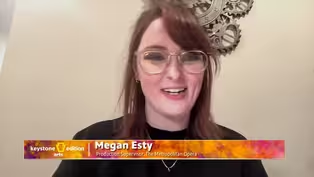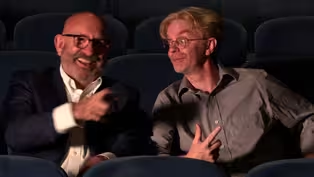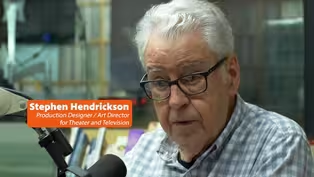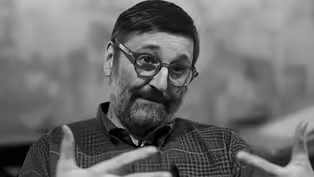Keystone Edition
Behind the Scenes: Scenic and Costume Design in Theater
Clip: 2/24/2025 | 11m 6sVideo has Closed Captions
Exploring the artistry of set and costume design, from community theater to the Metropolitan Opera.
Award-winning scenic designer Michael Gallagher reflects on his decades-long career, from small theaters to major productions. Meanwhile, Megan Esty shares a touching story about ensuring performers’ comfort at the Metropolitan Opera. Keystone Edition Arts explores the unseen artistry that brings stage performances to life, from intricate set designs to carefully crafted footwear.
Problems playing video? | Closed Captioning Feedback
Problems playing video? | Closed Captioning Feedback
Keystone Edition is a local public television program presented by WVIA
Keystone Edition
Behind the Scenes: Scenic and Costume Design in Theater
Clip: 2/24/2025 | 11m 6sVideo has Closed Captions
Award-winning scenic designer Michael Gallagher reflects on his decades-long career, from small theaters to major productions. Meanwhile, Megan Esty shares a touching story about ensuring performers’ comfort at the Metropolitan Opera. Keystone Edition Arts explores the unseen artistry that brings stage performances to life, from intricate set designs to carefully crafted footwear.
Problems playing video? | Closed Captioning Feedback
How to Watch Keystone Edition
Keystone Edition is available to stream on pbs.org and the free PBS App, available on iPhone, Apple TV, Android TV, Android smartphones, Amazon Fire TV, Amazon Fire Tablet, Roku, Samsung Smart TV, and Vizio.
Providing Support for PBS.org
Learn Moreabout PBS online sponsorship- Stephen Hendrickson, longtime set designer and art director for films, like "The Muppets Take Manhattan," "Wall Street" and "Arthur."
And we were so glad to visit his little, little sets.
Michael Gallagher is an award-winning scenic designer who studied with the distinguished set and lighting designer Klaus Holm at Wilkes.
Gallagher went on to establish a theater program in Pennsburg, Pennsylvania, and honed his skills at the Colorado Springs Opera Festival.
He also designed sets for Scranton Public Theater, Theater Under the Tent on Montage Mountain, and the Masonic Temple.
He retired after 36 years at the Music Box Playhouse and is now a board member Emeritus.
And along the way he played some unforgettable characters, Hansel in Lederhosen, is that right Michael?
- It is quite a sight I was.
- So good to have you with us.
- Thank you.
- You are known as a wonder worker among those who are part of the theater community in this region.
You've created sets of all shapes and sizes for the admittedly, admittedly small stage at Music Box and you amaze audiences and crew alike, whether you take us to "Anatevka" or "River City" or to "The Land of Oz."
And we want to know what drew you to the art of scenic and theater design in the first place?
- When I was a very young lad, probably when I was 17, I was invited to go to the first summer theater workshop in this region for high school students, for juniors and seniors at Wilkes University and then Wilkes College at the 2-year-old Dorothy Dickson Darte Center.
It was a state of the art theater and one of the finest facilities on the eastern seaboard at that time.
Believe it or not, The National Endowment of the Arts provided millions of dollars for colleges throughout the country to have a workshop where they would bring high school students together with graduate students who were teachers of English and theater and high schools.
And the idea was to try to improve theater in high schools.
They'd bring us together with these graduate students, the graduate students would direct us in plays.
And we were supposed to go back to our high schools and to try to lay a foundation for the improvement of theater in high schools.
In the 70s, rather the 60s, there wasn't a whole lot of theater happening in high schools.
This workshop was six weeks all day.
We went from nine to nine.
And the great thing was, that's where I learned to love.
I mean, I was a kid in a candy store.
This theater is magnificent and it still remains one of the best facilities in this region.
It had a full fly system.
It had this amazing new lighting system that even Broadway theaters didn't have that Heim have.
And so it was a wonderful experience and I did have, I broke in being not in performing, but we had to, all of us in students become a part of one of the technical aspects of the show.
One week I'd work on lights, the next week we were in props, the week after that set construction and lighting.
One of the things I remember was that we were building a flat for one of the shows, and one of the student directors asked me to get a pair of pliers.
I went to the tool room and came back with a crescent wrench.
And he looked at me and he said, "Do you know the difference between a crescent wrench and a pair of pliers?"
And I said, "I guess not."
What I did was a kid who was with me who knew a lot about tools said, "I'll take you to the tool room and I'll tell you exactly what everything is."
But that's where I started.
I went to Wilkes then and I loved being part of the backstage crew and building sets, and.
- What about Klaus Holm, was he there at the time?
- Klaus Holm when I was a sophomore, or junior, 1970, he became the technical director and scenic designer for the theater.
The reason why he got there is he was working for a firm called the Donald Oenslager's, a Theater Consultant Company.
Now, Donald Oenslager was one of the greatest designers of the 20th century in America.
So Klaus worked for him in addition to having been also a set designer and lighting designer himself in New York.
(coughing) And also he also designed industrial lighting for the 1960 world sphere, for example.
He did the, all of the outside lighting, the lighting stanchions and everything.
(coughing) I'm sorry.
And so Klaus was the first person I met who I ever saw paid a backdrop and he taught me how to do that.
He was a great scenic painter and he had consulted on the building of the theater.
So Al Groh, who was the director of the theater, brought him in then to become the technical director.
And Klaus, took it up.
He was a great mentor, a great teacher.
- What about working with Jason Miller, the Pulitzer Prize winner for that championship season?
You actually designed a set with him, for him.
- Yes, I did, I designed lots of sets and I was watching you the introduction before, in the beginning of the show of Santo Loquasto.
Santo Loquasto, I had met very briefly once at Montage Mountain when they were doing this Pennsylvania summer theater festival.
'Cause many of Jason Miller's old cronies and friends would come to visit him, including Santo at one point.
And the irony of this situation is that Santo was from Wilkesboro, graduated from Kings, went to Yale.
Jason Miller I think also went to Yale as well.
And he's from Scrantonm Santo Loquasto was from Wilkesboro.
But they get together in their first ventures to collaborate on that championship season in New York in 1972, I think it was one of Loquasto's first set designs and of course a great pool of surprise, and Tony Award-winning play that Jason Miller wrote that championship season.
- Now we have the image of what you designed, what were some of, now we don't have lots of times, but what were some of the considerations that you, knowing this area and knowing that the play is set in Scranton, what are some of the things that you had to take into consideration for your design?
- Well, in reading the play, of course there are very specific areas that dictate where the steps are, where the entrances are, where this very famous table of this golden trophy cup has to be placed.
And well, there it is.
And there there was a rack of rifles as I remember that he wanted to have placed on there.
And he did mention to me that he had remembered glass windows, stained glass windows that in both in the front door and a window that he'd liked to integrate into the set.
And it was a bit in intimidating for me to do this set, knowing that there was this man, Santo Loquasto, who had designed it for him and won a Tony Award nomination himself.
I said, "I don't know if I can can do anything like this."
It was quite different than the experience that, and I did see that production in New York.
It was wonderful.
It was a great play, great set.
Fortunately, the difference was that we were doing this in a thrust stage on a tent.
We could only go so high because at the top of the set should scratch the tent.
You could rip the tent wide open.
Everything had to be padded at the top.
But it worked.
And I do know that at one point when I met very briefly, Santo Loquasto, Jason did mention I had designed this shelf and he said, and Santo Loquasto said, "And I understand from Jason, you did a very nice job."
I thanked him so much for that compliment.
He is from everybody, I've known people who have worked with him, early teachers, and they've all said he was a wonderful man.
- Wow, well, we are so pleased to have those stories because we wouldn't know otherwise, Michael.
And again, people do respect you so much.
- Oh, thank you.
- For what you're able to do.
Not just in the small space of Music Box, but under a tent, for example.
A little theater.
Megan, we come back to you and just say, do you have a story, kind of a neat shoe story that you can tell and share with us about the Met?
- I think what comes to me was, most recently, when we were doing "The Magic Flute" in December, a chorus man come to me, and his feet have been changing a little bit this year.
And it happens, you know, as we age and sometimes our chorus ladies get pregnant and like, your feet get wider and that's normal and it's okay, but he was very self-conscious about it.
And I worked with our designer and I worked with the chorister through multiple like conversations and some shoe fittings with him.
And I was able to get him into two new pairs of shoes for this show.
And he came to me one day and said, "I have to tell you, I always feel like I'm going to stage missing something.
I always feel like I'm missing something.
And what I realized that what I'm missing is that my feet were in so much pain and now they're not, because you fixed that for me.
And I'm grateful that you've made me more comfortable performing, so."
- Thank you.
- It's not a fun story but it's a very touching one.
I love that I can do that for my performers.
- It is wonderful.
And you know, we thank you, Michael.
We thank you, Megan.
And this at every episode of "Keystone Edition" is available on demand
The Art of Stagecraft: Shoes, Costumes, and Set Design
Video has Closed Captions
Clip: 2/24/2025 | 9m 1s | Exploring the role of shoes and stagecraft in theatrical and operatic productions. (9m 1s)
Preview: 2/24/2025 | 30s | Watch Monday, February 24th at 7pm on WVIA TV (30s)
From Film to Miniatures: The Art of Set Design
Video has Closed Captions
Clip: 2/24/2025 | 4m 5s | Stephen Hendrickson shares insights on film set design and his intricate miniature theater displays. (4m 5s)
Santo Loquasto: A Legacy in Scenic and Costume Design
Clip: 2/24/2025 | 1m 42s | Celebrating the award-winning career of designer Santo Loquasto in theater, film, and dance. (1m 42s)
Providing Support for PBS.org
Learn Moreabout PBS online sponsorship
- News and Public Affairs

Top journalists deliver compelling original analysis of the hour's headlines.

- News and Public Affairs

FRONTLINE is investigative journalism that questions, explains and changes our world.












Support for PBS provided by:
Keystone Edition is a local public television program presented by WVIA



